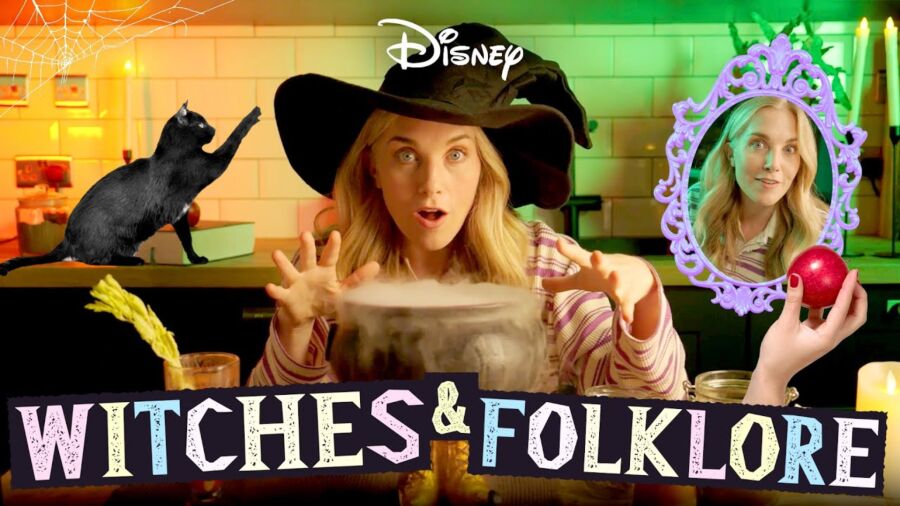 https://ridingthemagic.uk/about/terms-of-service
https://ridingthemagic.uk/about/contact-us
Disney UK
Disney UK
https://ridingthemagic.uk/about/terms-of-service
https://ridingthemagic.uk/about/contact-us
Disney UK
Disney UK
It’s Saturday, and naturally we were excited for another episode of Mapping the Magic, the new Disney UK series that promised to take us around the country uncovering magical inspirations. Sadly, episode 2 didn’t quite cast the spell that we had hoped for.
The title teased a deep dive into how Disney witches were inspired by the UK’s own witch trials and folklore. Instead we got a six-minute mash up of stock footage, (Scotland, we see you), and surface-level storytelling that barely scratched the surface.
Even with Maddie’s charm, this episode fizzed faster than a damp wand. So, while we didn’t get the magic on screen, here are a few fascinating facts that should have been included, because the link between British history and Disney’s witches is too good to miss.
5 Fascinating Facts About Disney Witches and British History
1: Maleficium and Maleficent
It is in the Elizabethan Witchcraft Act, that you find the origins for the name of one of Disney’s most famous villains, Maleficent. This particular act written into British law, criminalised the use of harmful magic which it called maleficium. It’s a Latin term which means “evil deed”, “wrongdoing”, or “mischief”. It’s no coincidence that Disney’s most iconic villain, Maleficent, finds her name deeply entwined in this historical root.
2: The Sanderson Sisters & Shakespeare’s Witches
The Hocus Pocus trio of witches, Winifred, Mary, and Sarah, share striking similarities with Shakespeare’s witches in Macbeth, showing this Salem based film was clearly inspired by UK witch history too. When Winifred stirs her cauldron in the opening scene and chants:
"Bring to a full rolling bubble. Add two drops oil of boil"
It’s a clear nod to the lines of the witches in Macbeth, by William Shakespeare:
"Double, double toil and trouble; Fire burn and cauldron bubble."
Just like in UK history, the Sanderson sisters faced hanging rather than burning for their acts as witches; a detail true to the British witch trials before the rule of James I.
3: Ursula And British Folklore
Many fans know that The Little Mermaid is based on Hans Christian Andersen’s fairy tale, but few realise that Disney’s Ursula also has chilling echoes of real British history, specifically the North Berwick Witch Trials of 1590.
When King James VI of Scotland set sail in 1589 to collect his new bride, Anne of Denmark, fierce storms affected his voyages, even sinking one of the royal fleet on the return journey. King James accused a group of women from North Berwick of plotting his death through dark sea magic.
The storm Ursula conjures in the sea to prevent Eric and Ariel from being together is strikingly similar to this British story.
4: The Evil Queen And The Magic Mirror of Elizabethan England
While Snow White is a German tale at heart, the Evil Queen’s character draws heavily from the world of Elizabethan England; a time when power, beauty, and sorcery intertwined.
At Queen Elizabeth I’s court, appearance was everything. Portraits were retouched, grey hairs hidden, and youth carefully staged. It was a culture obsessed with mirrors and self-image. The Queen’s vanity and control of her likeness became the stuff of legend, inspiring the work of many great British writers.
But beyond the cosmetics, mirrors carried a mystical meaning. (Not the meaning Maddie talks about either). Queen Elizabeth’s own astronomer, Dr John Dee, used a black obsidian “shew-stone” to communicate with angels and reveal truths. It can be said to be the real life equivalent of a person using a ‘magic mirror’.
It’s no wonder Disney’s first villain reflects this era so well: a queen consumed by envy, using magic mirrors to preserve her beauty, and power. In many ways, she’s part Tudor courtier and part-occultist, and, of course, entirely timeless.
5: Madame Mim and Britain’s Wise Women
Before the word witch became synonymous with evil in the UK, many of the accused were seen in their villages as wise women. They were healers, herbalists, and midwives, women who understood nature, medicine, and folklore. But as fear of witchcraft spread across Britain, and the 1542 laws against acts of witchcraft changed the landscape, these same women were recast as dangerous, their knowledge cast into superstition.
Disney’s Madame Mim is a playful echo of that shift. Her chaotic spells and wild appearance parody the misunderstood wise woman, once respected, now mocked and feared. In the Middle Ages, women like Mim were often branded as troublemakers simply because they lived independently.
So while Disney turns her into comic relief, the bones of her story come straight from Britain’s real witchcraft history, where a wise woman’s power could one day heal a neighbour and the next see her condemned as a witch.
Magic in a Minute
Episode 2 promised a magical journey through Britain’s witchy history but delivered more broomstick bumps than spells. Still, the real-world links between Disney witches and British folklore are rich, eerie, and endlessly fascinating.
If you’re as hooked on the crossover between Disney magic and the UK as we are, stay tuned. It looks like Mapping the Magic will continue to drop new episodes at 9am every Saturday. Let’s hope next week’s instalment delivers a little more enchantment. We reviewed episode one, so if you aren’t sure about tuning in why not find out if the show is for you by reading that next.
